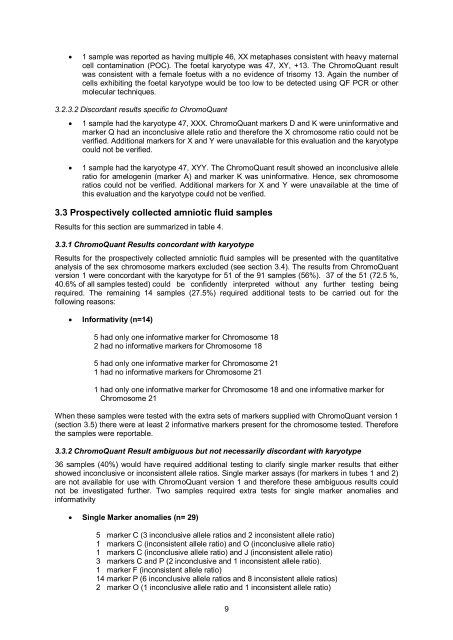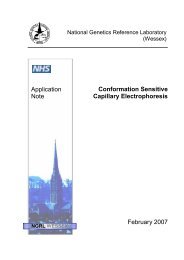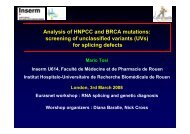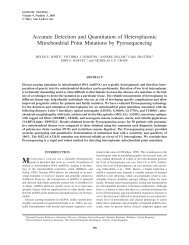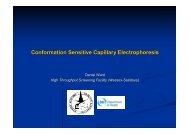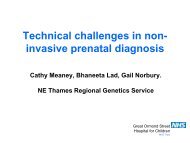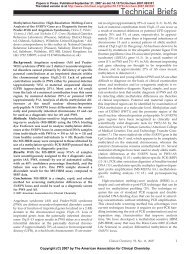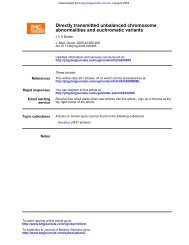(Wessex) Technology Assessment ChromoQuant⢠(version 1)
(Wessex) Technology Assessment ChromoQuant⢠(version 1)
(Wessex) Technology Assessment ChromoQuant⢠(version 1)
You also want an ePaper? Increase the reach of your titles
YUMPU automatically turns print PDFs into web optimized ePapers that Google loves.
· 1 sample was reported as having multiple 46, XX metaphases consistent with heavy maternalcell contamination (POC). The foetal karyotype was 47, XY, +13. The ChromoQuant resultwas consistent with a female foetus with a no evidence of trisomy 13. Again the number ofcells exhibiting the foetal karyotype would be too low to be detected using QF PCR or othermolecular techniques.3.2.3.2 Discordant results specific to ChromoQuant· 1 sample had the karyotype 47, XXX. ChromoQuant markers D and K were uninformative andmarker Q had an inconclusive allele ratio and therefore the X chromosome ratio could not beverified. Additional markers for X and Y were unavailable for this evaluation and the karyotypecould not be verified.· 1 sample had the karyotype 47, XYY. The ChromoQuant result showed an inconclusive alleleratio for amelogenin (marker A) and marker K was uninformative. Hence, sex chromosomeratios could not be verified. Additional markers for X and Y were unavailable at the time ofthis evaluation and the karyotype could not be verified.3.3 Prospectively collected amniotic fluid samplesResults for this section are summarized in table 4.3.3.1 ChromoQuant Results concordant with karyotypeResults for the prospectively collected amniotic fluid samples will be presented with the quantitativeanalysis of the sex chromosome markers excluded (see section 3.4). The results from ChromoQuant<strong>version</strong> 1 were concordant with the karyotype for 51 of the 91 samples (56%). 37 of the 51 (72.5 %,40.6% of all samples tested) could be confidently interpreted without any further testing beingrequired. The remaining 14 samples (27.5%) required additional tests to be carried out for thefollowing reasons:· Informativity (n=14)5 had only one informative marker for Chromosome 182 had no informative markers for Chromosome 185 had only one informative marker for Chromosome 211 had no informative markers for Chromosome 211 had only one informative marker for Chromosome 18 and one informative marker forChromosome 21When these samples were tested with the extra sets of markers supplied with ChromoQuant <strong>version</strong> 1(section 3.5) there were at least 2 informative markers present for the chromosome tested. Thereforethe samples were reportable.3.3.2 ChromoQuant Result ambiguous but not necessarily discordant with karyotype36 samples (40%) would have required additional testing to clarify single marker results that eithershowed inconclusive or inconsistent allele ratios. Single marker assays (for markers in tubes 1 and 2)are not available for use with ChromoQuant <strong>version</strong> 1 and therefore these ambiguous results couldnot be investigated further. Two samples required extra tests for single marker anomalies andinformativity· Single Marker anomalies (n= 29)5 marker C (3 inconclusive allele ratios and 2 inconsistent allele ratio)1 markers C (inconsistent allele ratio) and O (inconclusive allele ratio)1 markers C (inconclusive allele ratio) and J (inconsistent allele ratio)3 markers C and P (2 inconclusive and 1 inconsistent allele ratio).1 marker F (inconsistent allele ratio)14 marker P (6 inconclusive allele ratios and 8 inconsistent allele ratios)2 marker O (1 inconclusive allele ratio and 1 inconsistent allele ratio)9


